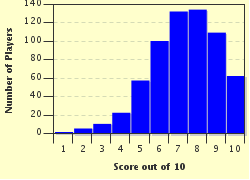Quiz Answer Key and Fun Facts
1. Which of these is a word meaning a belief that there is a single god?
2. Someone who dies for their faith is called a martyr. Which of these is considered to have been the first Christian martyr?
3. Many religions have a tradition of monasticism, the practice of living apart from the mainstream of society and devoting one's life to religious asceticism for the purpose of spiritual development. In which religion are monks and nuns often called muni?
4. Although the veracity of the Biblical account has been debated, who is said to have talked to God in a burning bush, led the Jewish people out of Egypt, received the Ten Commandments in a second encounter with God on Mount Sinai, and died after 40 years spent in the wilderness, just before the Promised Land was reached?
5. Which of these Biblical figures is considered the author of one of the portions of the Bible where you will find the sayings called Beatitudes?
6. He is thought to have been born in Mecca in the year 570 as a member of the Banu Hashim clan, part of the Quraysh tribe, arriving six months after the death of his father. According to tradition, which prophet spent the first two years of his life in the desert being cared for by Bedouin step-parents?
7. In the Hindu pantheon, which of these gods is considered to be one of the Mahadevas (great gods)?
8. According to Buddhists, complete understanding of the three marks of existence can release one from sansara, the cycle of birth and death. Which of these, probably the most familiar of these terms to many, is NOT one of the three marks of existence?
9. You have probably heard the Sanskrit word mahatma used as a term of respect, such as referring to Mohandas Gandhi as Mahatma Gandhi. What does the word mahatma literally mean?
10. While they are often referred to as mythology, the spiritual beliefs of the indigenous people of Australia are an active force in the spiritual life of many, not just a bunch of stories. According to the beliefs of the Aranda people of Central Australia, which of these was responsible for creating human beings?
Source: Author
looney_tunes
This quiz was reviewed by FunTrivia editor
CellarDoor before going online.
Any errors found in FunTrivia content are routinely corrected through our feedback system.


